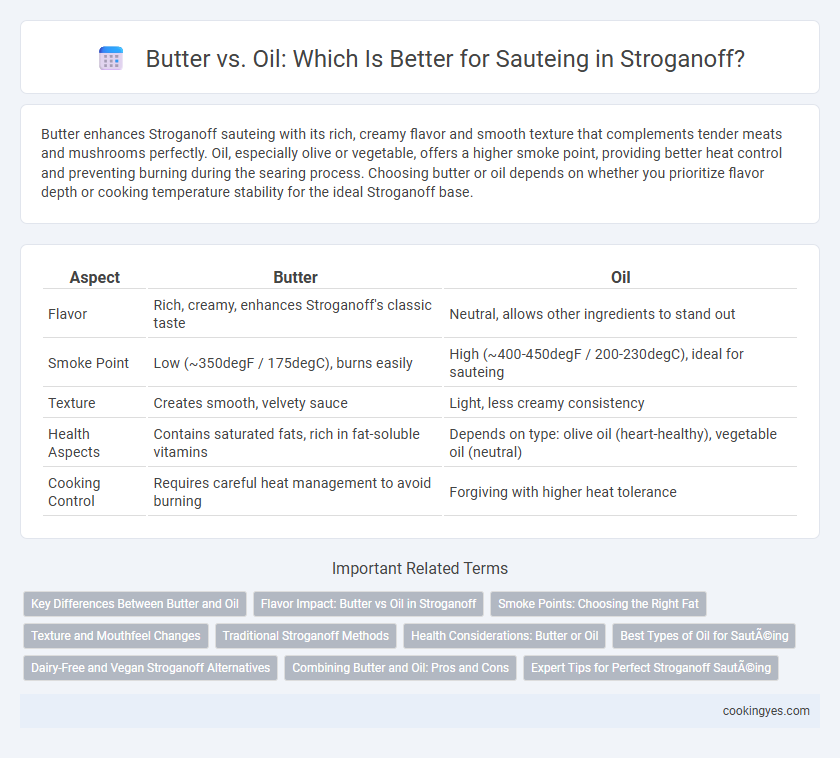Butter enhances Stroganoff sauteing with its rich, creamy flavor and smooth texture that complements tender meats and mushrooms perfectly. Oil, especially olive or vegetable, offers a higher smoke point, providing better heat control and preventing burning during the searing process. Choosing butter or oil depends on whether you prioritize flavor depth or cooking temperature stability for the ideal Stroganoff base.
Table of Comparison
| Aspect | Butter | Oil |
|---|---|---|
| Flavor | Rich, creamy, enhances Stroganoff's classic taste | Neutral, allows other ingredients to stand out |
| Smoke Point | Low (~350degF / 175degC), burns easily | High (~400-450degF / 200-230degC), ideal for sauteing |
| Texture | Creates smooth, velvety sauce | Light, less creamy consistency |
| Health Aspects | Contains saturated fats, rich in fat-soluble vitamins | Depends on type: olive oil (heart-healthy), vegetable oil (neutral) |
| Cooking Control | Requires careful heat management to avoid burning | Forgiving with higher heat tolerance |
Key Differences Between Butter and Oil
Butter provides a rich, creamy flavor and adds a luxurious texture to Stroganoff, but it has a lower smoke point, making it prone to burning at high sauteing temperatures. Oil, especially vegetable or canola oil, offers a higher smoke point that allows for more intense searing without smoke, but it imparts a neutral flavor that doesn't enhance the dish as much as butter. Choosing between butter and oil for Stroganoff sauteing depends on the desired flavor profile and cooking temperature control.
Flavor Impact: Butter vs Oil in Stroganoff
Butter imparts a rich, creamy flavor essential for authentic Stroganoff, enhancing the dish's savory depth with its slightly nutty notes. Oil, typically vegetable or olive oil, provides a neutral base that allows other ingredients to shine but lacks the distinctive taste butter brings. Using butter for sauteing mushrooms and onions in Stroganoff elevates the flavor profile, creating a more indulgent and traditional experience.
Smoke Points: Choosing the Right Fat
Butter, with a smoke point around 350degF (175degC), provides rich flavor but can burn quickly when sauteing Stroganoff at higher temperatures. Oils like canola or vegetable oil, which have higher smoke points near 400degF (205degC) or more, better withstand the heat, preventing bitter burnt notes in the dish. Blending butter with high-smoke-point oil balances flavor and temperature control, ensuring a perfectly sauteed Stroganoff base.
Texture and Mouthfeel Changes
Butter enhances Stroganoff sauteing by contributing a rich, creamy texture and a smooth mouthfeel due to its milk fat content, which promotes browning and caramelization. In contrast, oil, especially neutral oils like canola or vegetable oil, provides a higher smoke point, allowing for faster cooking without burning but results in a lighter, less creamy texture. Combining butter and oil can optimize texture by balancing richness with a stable cooking temperature, yielding a tender and velvety Stroganoff sauce.
Traditional Stroganoff Methods
Traditional Stroganoff methods favor butter for sauteing due to its rich flavor and ability to create a creamy texture essential to the dish. Butter's milk solids contribute to the characteristic golden-brown crust on the meat, enhancing depth and authenticity. While oil offers a higher smoke point, butter remains preferred to achieve the classic Stroganoff taste and mouthfeel.
Health Considerations: Butter or Oil
Choosing between butter and oil for Stroganoff sauteing impacts health factors such as fat composition and smoke point. Butter contains saturated fats and provides rich flavor but has a lower smoke point, increasing the risk of harmful compounds when overheated. Oils like olive or canola offer healthier unsaturated fats and higher smoke points, making them a better option for maintaining nutritional value during cooking.
Best Types of Oil for Sautéing
For sauteing Stroganoff, oils with high smoke points like avocado oil, refined olive oil, or grapeseed oil ensure even cooking without burning. Butter adds rich flavor but can scorch quickly at high heat, so combining it with oil often balances taste and temperature control. Using the right oil enhances the dish's creamy texture while preserving the delicate beef and mushroom flavors.
Dairy-Free and Vegan Stroganoff Alternatives
For dairy-free and vegan Stroganoff alternatives, choosing oil over butter is essential to maintain a plant-based profile and avoid dairy allergens. Oils like olive, avocado, or coconut provide a neutral base for sauteing mushrooms and onions, key ingredients in Stroganoff, while contributing healthy fats and enhancing flavor without compromising vegan standards. Using oil also prevents the risk of butter browning too quickly at high heat, ensuring a smooth and consistent saute for a perfect dairy-free Stroganoff.
Combining Butter and Oil: Pros and Cons
Combining butter and oil for sauteing Stroganoff enhances flavor and raises the smoke point, allowing for better browning without burning the butter. Butter contributes rich, creamy taste while oil, such as vegetable or olive oil, provides stability at higher temperatures. This blend balances depth of flavor with cooking efficiency, though careful temperature control is needed to prevent separation or burning.
Expert Tips for Perfect Stroganoff Sautéing
Butter offers a rich, creamy flavor that enhances Stroganoff's traditional taste, while oil provides a higher smoke point, preventing burning during high-heat sauteing. Experts recommend clarifying butter to combine the depth of butter with the stability of oil for an optimal Stroganoff saute. Using a mix of clarified butter and a neutral oil like canola maintains moisture and achieves the signature tender texture vital for authentic Stroganoff.
Butter vs oil for Stroganoff sautéing Infographic

 cookingyes.com
cookingyes.com